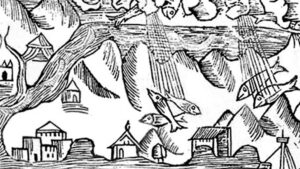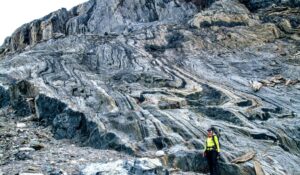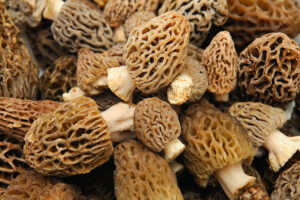Along the beaches of Oregon’s Coast, you will find ghostly remnants of ancient trees peaking above the sand and the sea’s rolling tides. These are appropriately called “ghost forests”, coastal areas containing dead trees submerged in sand and/or seawater.
Background
The Neskowin Ghost Forest lies in Tillamook County. In the late 1990s, the area suffered a series of severe weather events which washed copious amounts of sand out into the sea. The displacement of the sand revealed over 100 stumps of Sitka spruce trees. Carbon dating of this ancient forest suggested that it was 2,000 years old.
Research shows the trees once stood between 45m and 60m tall. Their roots and soil lie far beneath the sand.

An eerie sight on a gloomy day. Photo: kojihirano/Shutterstock
But the trees are dead. The National Oceanic and Atmospheric Administration (NOAA) describes the trees as “poisoned”. The “invading seawater advanced and overtakes the freshwater that deciduous trees rely on for sustenance,” it explained.
Since the storms uncovered them, the stumps have withstood the changes in tides and have not disappeared again beneath the sands. While the tops of the stumps suffer from rot and erosion, their trunks remain intact because of anoxic conditions in the mixture of sand, debris, sediment, and forest soil below the surface. Some stumps house groups of starfish; barnacles completely cover others. Each stump has a unique character. The best time to see them is at low tide and during winter.
The debate
How did the Neskowin Ghost Forest begin?
This area is a tectonically volatile location called the Cascadia Subduction Zone, where the Juan de Fuca, Explorer, and Gorda Plates subduct under the North American plate. This highly active area stretches 1,000km from Vancouver Island to Northern California. One popular online theory points to an 8.0 or 9.0 magnitude earthquake in the Cascadia Subduction Zone that devastated Oregon in late January 1700. The theory suggests that the earthquake caused portions of land to settle dramatically below sea level. A subsequent tsunami then hit the Oregon Coast, submerging the once verdant forest.

Some tree stumps are covered in barnacles. Photo: Michael Warwick/Shutterstock
However, the likelier scientific argument does not involve a major earthquake. The two main authorities on the subject, geologists Curt Peterson and Roger Hart, studied over 200 stumps on the coast. In their official study, Episodically Buried Forests in the Oregon Surf Zone, they credit “eustatic change of sea level and migration of sand barriers.” They believe that “wind, storms, tsunamis or debris flows could have broken off the trunks.”
In their theory, sand encroached on the forest little by little, resulting in the slow decay of the tree trunks.
An omen of climate change
Forty-five known ghost forests dot the Oregon Coast, including those on Arch Cape, Whiskey Run, and Otter Point. Some date back 80,000 years. You can also find ghost forests on other coastlines around the world. While mesmerizing and a treasure trove for researchers, they now indicate the effects of climate change. Rising sea levels have reclaimed hundreds of these forests.






